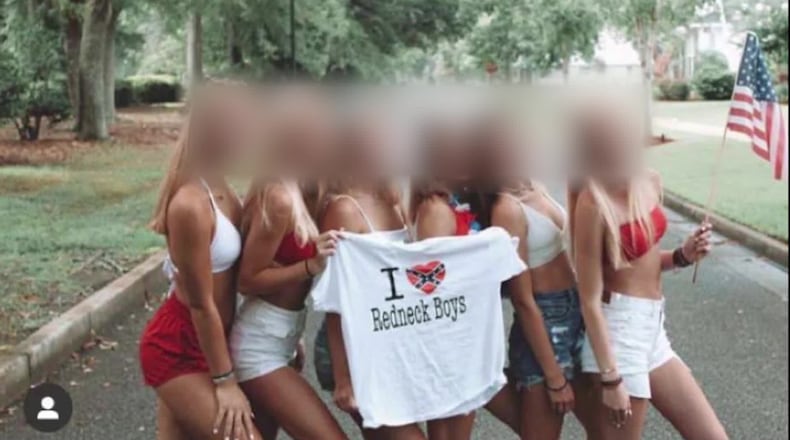A petition is calling for the removal of several members of an Alabama high school cheer team after a photo appeared on Instagram showing them posing with a T-shirt that depicted the Confederate battle flag and the phrase “I love redneck boys.”
Reagan Coleman, one of only two Black cheerleaders on the Daphne High School squad, quit after the first practice because she said coaches and teammates refused to address the matter which had been brewing among them for two weeks, according to WKRG News 5 in Mobile.
»MORE: Many Americans view Confederate flag as symbol of pride, not racism, poll finds
“No matter how much I love something, no matter how passionate I am about something, I love myself more and I respect myself more, and I could not be on that team,” Reagan told the station.
Her mother, Latitiah Coleman, said she immediately contacted school administrators about the image, which shows six white coeds posing shoulder to shoulder with the Confederate T-shirt held in the middle of them. The girl at the front of the line is also holding an American flag.
“I went from the coach to the principal, from the principal to the superintendent. And I kept getting vague answers. It was almost like everybody was reading a script,” Latitiah told WKRG, which first reported about the controversy a week ago.
»LAST WEEK: ‘Rednecks For Black Lives’ urges Southerners to fight for racial equality
Baldwin County Public Schools has since issued a statement acknowledging the matter.
“We are aware of the situation and it has been handled at the local school level. As with any student issue, federal law prohibits us from discussing disciplinary actions, if any, involving our students. Our system has implemented sensitivity programs and Superintendent Tyler has stressed that we have a zero tolerance for racism and bullying in our system.”
»FROM JULY: As a candidate, Trump said Confederate flag should be ‘put in a museum’
Reagan said the photo was just the latest in a series of racist incidents that have surfaced on the team.
She told WKRG about a video that recently appeared on Instagram allegedly showing a Daphne cheerleader dropping the N-word during basketball season, and about another cheerleader calling a classmate the N-word in a Snapchat message.
In the latest episode, she told WKRG the school district didn’t do enough, saying none of the girls involved apologized or lost their spots on the team.
“I feel like we’re at a time where Black voices are being heard. We’re being felt; we’re being seen. So I knew this couldn’t go unheard about. I knew I needed to share this story not for me or how I felt about the picture, but because of the other Black children that may be silenced by white administrations like these,” she said.
Several voices have been sounding off about the photograph on social media in recent days.
The student who first posted the image to Instagram reportedly removed it in a matter of hours after a flurry of negative reactions, the station reported.
The petition to remove the girls from the team has gained nearly 1,000 signatures so far.
Flag under fire
The Confederate battle flag, featuring a diagonal blue cross with stars, is widely seen by minority groups as a potent symbol of slavery and white supremacy in America.
“There’s no two sides to that flag. That means hatred. That’s what it stands for for us,” Latitiah Coleman told WKRG, her position reflecting the long-held beliefs of many Black people. “We were oppressed with that flag. They used it when they burned crosses in our ancestors’ yards. When it was railed around on horses. I don’t know what history you’re reading, but if you read the U.S. history, it tells you exactly what that flag stands for and what it means, especially to African Americans.”
But about half the country views the Confederate battle flag as a symbol of Southern pride, according to recent polling by Politico and Morning Consult.
Displaying the flag has become even more controversial in the wake of George Floyd’s death.
Last month, the military banned the display of the Confederate flag in public and work areas on bases, ships, aircraft and submarines.
Cities around the country have also been forced to topple numerous relics of the Civil War that have been left damaged by protesters.
Activists are leading the call to rename Army bases and local municipalities currently named after Confederate generals.
History of the flag
The Confederate battle flag was designed by Southern secessionist William Porcher Miles in 1860, and it was first flown as the Civil War battle flag of Gen. Robert E. Lee’s Army of Northern Virginia.
The battle flag, however, was never adopted by the Confederate Congress, never flew over any state capitols during the Confederacy and was never officially used by Confederate veterans groups.
Nevertheless, it has become the most widely recognized symbol of the Confederacy.
The flag was resurrected by the resurgent Ku Klux Klan and used by Southern Dixiecrats during the 1948 presidential election. Organizations such as the Sons of Confederate Veterans have also adopted the flag as a symbol of Southern heritage.
The flag was popularized again in the 1980s hit TV show “The Dukes of Hazzard,” which featured an orange Dodge Charger with the battle flag painted on its roof. The car was aptly named The General Lee.
The flag in Georgia
On Feb. 13, 1956, the Georgia state flag was changed to incorporate the Confederate battle emblem into the design as a response to the Supreme Court ruling on school desegregation.
In the late 1980s, Black state legislators pushed to drop the state flag with the Confederate battle emblem and restore its predecessor, but they failed.
In 1994, James Coleman of Atlanta filed suit against then-Gov. Zell Miller and the state of Georgia over the state flag. Miller had said he wanted the Confederate emblem removed, but lawmakers wouldn’t pass such legislation and the matter was dropped.
The Georgia Legislature next approved a new flag in 2001 and again in 2003. Then in a March 2004 referendum, Georgia voters approved the state’s current flag, which closely resembles the first official national flag of the Confederacy, often called the Stars and Bars.
About the Author
Keep Reading
The Latest
Featured



